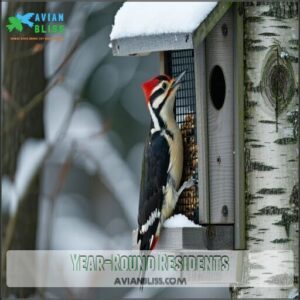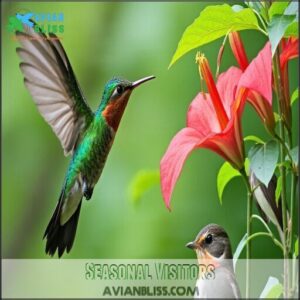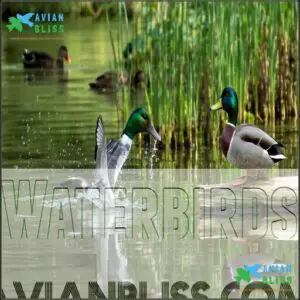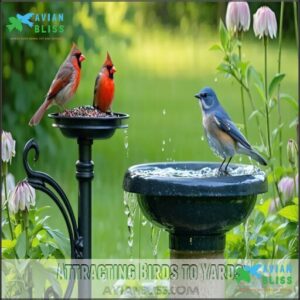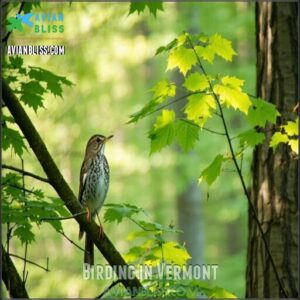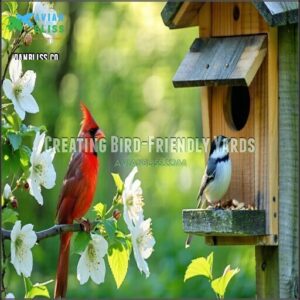This site is supported by our readers. We may earn a commission, at no cost to you, if you purchase through links.
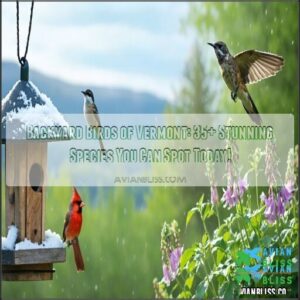
In winter, watch for Dark-eyed Juncos and Blue Jays at your feeders, while summer brings Baltimore Orioles and Rose-breasted Grosbeaks.
Year-round residents include Downy Woodpeckers, White-breasted Nuthatches, and American Goldfinches that transform from bright yellow to olive-drab as seasons change.
Vermont’s diverse habitats support everything from tiny Ruby-throated Hummingbirds to impressive Red-tailed Hawks.
The right combination of feeders and native plants can turn your yard into a birdwatcher’s paradise.
Table Of Contents
- Key Takeaways
- Backyard Bird Identification
- Common Vermont Birds
- Attracting Birds to Yards
- Birding in Vermont
- Creating Bird-Friendly Yards
- Frequently Asked Questions (FAQs)
- How can I identify a bird in my yard?
- What is Vermont’s state bird?
- Which birds are found around your house?
- How do I know what birds are in my area?
- What are the top 31 backyard birds in Vermont?
- Which birds are common in Vermont?
- Do you see birds in Vermont in summer?
- Which bird feeder attracts the most birds in Vermont?
- Which bright yellow bird is common in Vermont?
- Where can I watch birds in Vermont?
- Conclusion
Key Takeaways
- You’ll find over 35 species of backyard birds in Vermont throughout the year, including the state bird (Hermit Thrush), chickadees, cardinals, and seasonal visitors like orioles and grosbeaks.
- You can attract more birds to your yard by providing the right combination of feeders, water features (like shallow birdbaths), and native plants (such as dogwood and buttonbush).
- You’ll identify Vermont birds more easily by observing their size compared to familiar objects, distinctive plumage patterns, beak shapes, and listening for unique calls like the chickadee’s "dee-dee-dee."
- You can create a bird-friendly habitat by reducing pesticide use, installing different styles of feeders (including suet and peanut options), and providing proper shelter through native trees and shrubs that offer nesting sites.
Backyard Bird Identification
With careful observation, you’ll quickly identify Vermont birds by comparing their size to familiar objects and noting key field marks.
Spot Vermont’s feathered treasures by noting their size, distinctive patterns, and memorable songs—nature’s living jewels revealed through patient watching.
Look for distinctive plumage patterns, beak shapes, and flight styles that set each species apart.
Listen for unique bird songs—the chickadee’s "dee-dee-dee" is unmistakable!
Common backyard birds in Vermont reveal themselves through these characteristics, making identification an enjoyable skill anyone can develop.
Common Vermont Birds
You’ll find nearly 400 bird species throughout Vermont’s diverse habitats, from the cheerful Black-capped Chickadee to the striking Northern Cardinal.
Whether you’re watching from your kitchen window or exploring local parks, you’re sure to encounter these feathered neighbors going about their daily routines in the Green Mountain State.
Year-Round Residents
Vermont’s resilient feathered friends remain faithful backyard companions through all four seasons, showcasing remarkable adaptation strategies for winter survival.
The Hermit Thrush, Vermont’s official state bird since 1941, graces yards with its sweet melodious call year-round. You’ll spot American Robins hunting for worms even when snow blankets the ground, demonstrating their impressive winter survival techniques.
Common year-round residents in Vermont backyards include:
- Black-capped Chickadees, the friendly acrobats that flit between branches with characteristic dee-dee-dee calls
- American Goldfinches, which maintain their territory despite dulling their bright yellow plumage in winter
- American Crows, whose intelligent behavior and communal roosting help them thrive in changing seasons
These birds have developed specialized breeding habits and habitat needs that allow them to maintain stable population trends despite Vermont’s challenging climate. Providing backyard bird feeders can further support these resilient species throughout the year. Their presence transforms ordinary backyards into vibrant wildlife observation posts throughout the year, making them a faithful backyard companion.
Seasonal Visitors
Beyond the faithful year-round residents, seasonal visitors follow distinct migration patterns, bringing bursts of color and melody to your Vermont backyard.
Spring migration transforms quiet winter landscapes as songbirds return to establish nesting locations.
- Ruby-throated Hummingbirds arrive by May, their emerald plumage catching sunlight as they hunt for nectar to fuel their remarkable 80-beats-per-second wings
- Scarlet Tanagers and Red-eyed Vireos return from South America, their summer diet consisting primarily of insects found in treetops
- Snow Buntings and Bohemian Waxwings bring winter survival skills, gathering in flocks when temperatures drop
Attract more birds with backyard bird feeders.
Watch for dramatic plumage changes as seasons shift.
Birds of Prey
Swooping from songbirds to the skies above, keep your eyes peeled for Vermont’s magnificent birds of prey.
You’ll spot these backyard hunters displaying impressive raptor identification features and hunting techniques.
| Raptor Species | Hunting Techniques | Conservation Status |
|---|---|---|
| Red-tailed Hawk | Perches on tall trees, swoops down | Stable in Vermont |
| Sharp-shinned Hawk | Quick ambush through trees | Recovering |
| Great Horned Owl | Night hunting, silent flight | Common resident |
| American Kestrel | Hovers before striking | Declining numbers |
Their distinctive silhouettes against the evening sky tell a story of Vermont wildlife resilience. Remember, these predators help control rodent populations—nature’s pest control service right in your yard, showcasing the importance of wildlife conservation.
Waterbirds
While backyard raptors command the skies, Vermont’s waterbirds create peaceful scenes in wetland habitats.
You’ll find Common Mergansers with their distinctive green heads diving for fish in deeper waters. Mallards and American Black Ducks establish year-round nesting sites, while colorful Wood Ducks visit from March to October, displaying unique feeding habits.
During migratory patterns, watch for Buffleheads and Ring-necked Ducks stopping at your pond. Vermont wildlife enthusiasts appreciate how these backyard birds adapt to various water features—from small garden ponds to larger river systems—making bird identification a rewarding experience.
Some of these birds, like herons and egrets, primarily consume fish, which is a key aspect of their behavior in Vermont’s water ecosystems, showcasing their ability to thrive in various water features.
Attracting Birds to Yards
You’ll transform your Vermont yard into a bustling avian hub with the right combination of food sources, water features, and native plants that appeal to the state’s 388 documented bird species.
By providing black-oil sunflower seeds, installing birdbaths with gradual sides, and planting native shrubs like dogwood and buttonbush, you’re creating an irresistible habitat.
This habitat will have chickadees, cardinals, and bluebirds making regular appearances at your window.
Bird Feeders and Seed
Transform your yard into a Vermont bird paradise by choosing the right feeders and seed.
Proper selection attracts an astonishing variety of backyard birds while creating hours of birdwatching enjoyment.
- Black-oil sunflower seeds remain the gold standard, attracting everything from chickadees to cardinals with their high fat content
- Nyjer thistle in specialized tube feeders will bring goldfinches flocking to your yard, especially during winter feeding months
- Platform feeders with mixed seed blends work wonders for ground-feeding juncos and sparrows while minimizing wasted seed
Strategic feeder placement, about 10-12 feet from shrubs, provides safety while allowing for observation.
Regular feeder cleaning prevents disease spread.
Consider squirrel control measures like baffles or weight-sensitive feeders to guarantee your bird seed reaches its intended diners.
Birdbaths and Water Features
Water sources act as natural magnets for Vermont’s backyard birds.
Install a shallow birdbath with gradual sides where birds can safely perch and drink. Various birdbath materials work well—ceramic, stone, or concrete—just make certain they’re stable and easy to clean.
Place your water source near protective cover but away from predator hiding spots. Add a simple dripper to create enticing ripples; birds can’t resist the sight and sound of moving water.
During winter, heated birdbaths provide essential hydration when natural sources freeze. Maintain a cleaning frequency of once weekly to prevent algae growth and keep your feathered visitors returning for rejuvenating dips year-round, ensuring they always have access to moving water and a clean environment.
Native Plants and Trees
Beyond providing water, planting native Vermont trees and shrubs creates the ultimate bird-friendly habitat. Berry-producing shrubs like dogwood and buttonbush offer both shelter and food throughout the seasons.
Berry-producing native shrubs transform your yard into nature’s bird buffet—plant once, enjoy winged visitors forever.
Massive oaks support diverse bird populations, while serviceberry attracts hummingbirds with its nectar-rich flowers. When planning your backyard, consider nesting site selection—dense shrubs for songbirds and taller trees for woodpeckers.
Native tree benefits extend beyond birds to the entire ecosystem, making your contribution to bird conservation as simple as choosing plants that naturally belong in Vermont’s landscape, providing a diverse bird population.
Suet and Peanut Feeders
While native plants provide natural food sources, suet and peanut feeders offer irresistible treats that attract Vermont’s most fascinating birds.
These high-energy options are particularly valuable during cold months.
- Downy and hairy woodpeckers will visit upside-down suet feeders that exclude starlings
- Black-capped chickadees love peanut butter suet nuggets mixed with cornmeal
- Blue jays swoop in dramatically for whole peanuts in metal mesh feeders
- Tufted titmice and white-breasted nuthatches become regular visitors to peanut feeders
- Red-bellied woodpeckers cling acrobatically to suet cages
For best results, only offer suet when temperatures stay below 40°F to prevent spoilage. Clean your feeders weekly and remember to remove them during summer to avoid attracting bears. Your backyard birds will thank you!
Birding in Vermont
You’ll discover nearly 400 bird species across Vermont’s diverse landscapes, from the common Black-capped Chickadee that might investigate your hiking boots to the elusive Hermit Thrush singing its flute-like melody in the forest.
Whether you’re watching from your kitchen window or exploring wildlife refuges like Missisquoi, Vermont’s rich avian population offers year-round opportunities to connect with nature.
Prime Birdwatching Spots
Five spectacular birdwatching hotspots await you across Vermont’s diverse landscapes.
Dead Creek WMA in Addison serves as the crown jewel with its new visitor center, while Shelburne Bay offers over 200 species just minutes from Burlington.
Don’t miss Basin Harbor’s self-guided tours, the Connecticut River Valley’s important bird areas like Herrick’s Cove, or the Northeast Kingdom’s remote refuge habitats where rare forest species and migration hotspots create unforgettable wildlife encounters.
Bird Species Counts
While your binoculars might reveal fascinating birds at Vermont’s prime viewing locations, you’ll be amazed by the sheer numbers behind these sightings.
Vermont boasts an impressive 388 documented bird species as of recent data collection, with approximately 260 regular inhabitants.
Survey methods conducted by the Natural Heritage Database track 88 rare or at-risk species, helping scientists monitor population trends.
This accuracy in bird identification provides essential conservation impact data for both common birds and threatened species throughout Vermont’s backyard habitats.
Notable Birds in Vermont
Vermont’s landscape hosts several notable birds that birdwatchers enthusiastically seek. The melodic Hermit Thrush, Vermont’s state bird, fills forests with its flute-like song.
You’ll spot Black-capped Chickadees year-round, while the rare Bicknell’s Thrush represents one of Vermont’s most cherished declining bird populations.
- Ruby-throated Hummingbirds hover like tiny helicopters at feeders
- Majestic Bald Eagles soar along waterways, their comeback a conservation success story
- Vibrant Eastern Bluebirds flash azure against green fields
- Pileated Woodpeckers drum dramatically on dead trees, announcing their territory
These bluebirds often nest in man-made nest boxes.
Bird migration patterns bring seasonal variety to your backyard birds.
Conservation Efforts
While Vermont’s notable bird species charm backyard enthusiasts, conservation efforts guarantee these feathered neighbors continue thriving for generations.
Organizations like Audubon Vermont and the Vermont Center for Ecostudies spearhead initiatives that protect our avian friends from modern threats.
You can support Vermont birds through:
- Habitat Preservation: Plant native species in your yard to create micro-sanctuaries where birds can feed and nest naturally
- Citizen Science: Join community bird counts that help experts track population changes and migration patterns
- Reducing Threats: Keep cats indoors and install window decals to prevent common causes of bird mortality
Species monitoring programs across the state track vulnerable populations like the Bicknell’s Thrush, while public education campaigns help Vermonters understand the importance of backyard bird conservation efforts.
Every birdhouse you install contributes to the larger mission of protecting our state’s winged treasures.
Creating Bird-Friendly Yards
You’ll transform your property into a vibrant habitat for Vermont’s 388 bird species when you incorporate native plants, fresh water sources, and reduce pesticide use.
With a few simple changes to your yard, you can enjoy daily visits from colorful Northern Cardinals, curious Black-capped Chickadees, and melodious Eastern Bluebirds right outside your window.
Choosing Right Plants
Now that you’ve explored Vermont’s best birding spots, let’s bring those feathered friends to your doorstep! The foundation of any bird-friendly yard starts with smart plant selection.
Choose native plantings that Vermont birds naturally recognize as food and shelter needs. Your backyard birds will thank you with frequent visits!
Planting dense shrubs can offer protection from predators.
Berry production in summer
Seed sources in fall
Red cardinal flowers and native columbine are perfect for attracting hummingbirds.
Your bird conservation efforts begin right in your garden, creating thriving bird habitats that support local wildlife.
Building Birdbaths or Ponds
Water features in your yard can transform it into a bird haven. Birds need water not just for drinking but also for bathing and cooling off during Vermont’s warmer months.
Creating effective birdbaths or ponds requires attention to:
- Safe access with gently sloping sides so tiny birds won’t struggle
- Shallow water depths (1-2 inches) where birds can wade comfortably
- Perch placement near water edges for quick escape routes
- Regular cleaning to prevent algae buildup
Place your bird bath where you can watch the delightful splashing from inside. Many backyard birds will visit water features even before they discover your feeders, making these additions essential for creating a complete bird habitat.
Reducing Pesticide Use
After creating your perfect birdbath, protecting your Vermont birds from harmful chemicals is your next important step.
Pesticides threaten backyard birds both directly through poisoning and by eliminating their insect food sources. You’ll see more feathered visitors when you adopt birdfriendly practices like organic gardening techniques.
Try planting marigolds that naturally repel pests, or introduce natural predators like ladybugs to control aphids. Creating habitat health through diverse plantings establishes ecological balance without chemicals.
Neonicotinoids are particularly toxic to birds, so avoid these completely. Safe alternatives include targeted sprays made from soap and water, physical barriers for garden pests, mulching to suppress weeds, and encouraging native plants that support bird conservation through stronger natural ecosystems.
Providing Food and Shelter
With pesticides out of the picture, it’s time to welcome birds with the right food and shelter.
Vermont birds thrive when you provide a variety of natural food sources and safe havens in your yard.
Mix your bird feeding strategy by offering black-oil sunflower seeds for Cardinals, Nyjer thistle for Goldfinches, and suet for woodpeckers.
Different bird houses attract specific species—just be sure each has appropriate ventilation and predator protection.
- Your heart will skip when a family of chickadees makes their first home in your birdhouse
- Nothing beats the joy of watching fledglings take their first flight from your yard
- You’ll feel connected to nature when birds trust your space as their sanctuary
- The peace that comes from morning birdsong is better than any alarm clock
- There’s profound satisfaction in knowing you’ve helped wildlife thrive
Remember to provide nesting materials in spring and maintain year-round support through all seasons.
Frequently Asked Questions (FAQs)
How can I identify a bird in my yard?
Observe size, shape, colors, and behavior patterns first.
Note distinctive field marks like beak shape and plumage. Compare to familiar objects for size reference.
Listen for unique calls that can confirm identification.
What is Vermont’s state bird?
Like a woodland symphony master, Vermont’s state bird is the Hermit Thrush.
You’ll recognize this small brown songbird by its spotted breast, reddish tail, and hauntingly beautiful, flute-like melody.
It’s been Vermont’s official bird since 1941.
Which birds are found around your house?
You’ll likely find Northern Cardinals, Black-capped Chickadees, Blue Jays, and Tufted Titmice around your house in Vermont.
These common species visit feeders year-round, brightening your backyard with their distinctive colors and calls.
How do I know what birds are in my area?
Use binoculars, field guides, or bird identification apps like Merlin to spot local species.
Listen for unique calls, observe feeding patterns, and check with Vermont Audubon Society for your area’s common visitors, which can help you identify local species.
What are the top 31 backyard birds in Vermont?
You’ll regularly spot Black-capped Chickadees, Northern Cardinals, Blue Jays, Tufted Titmouse, Eastern Bluebirds, American Robins, House Finches, and Song Sparrows in Vermont yards.
Their cheerful presence varies with seasons and available food, making them a regular sight.
Which birds are common in Vermont?
You’ll commonly spot Black-capped Chickadees, Northern Cardinals, Blue Jays, and Tufted Titmice in Vermont. These year-round residents are joined by seasonal visitors like American Goldfinches, Dark-eyed Juncos, and Eastern Bluebirds.
Do you see birds in Vermont in summer?
Summer’s stunning songbirds surround you in Vermont.
You’ll enjoy an abundance of feathered friends, including Hermit Thrushes, Ruby-throated Hummingbirds, and Yellow Warblers that migrate to the state’s diverse habitats from May through September.
Which bird feeder attracts the most birds in Vermont?
Tube feeders filled with black-oil sunflower seeds attract the most Vermont birds, including cardinals, chickadees, and titmice. Platform feeders with mixed seed blends come in second for variety.
Which bright yellow bird is common in Vermont?
Like a flying burst of sunshine, the American Goldfinch is Vermont’s most common bright yellow bird.
You’ll spot them at your feeders year-round, though they’re brightest in summer, enthusiastically devouring nyjer thistle seeds.
Where can I watch birds in Vermont?
You’ll find excellent birdwatching at Missisquoi National Wildlife Refuge, Moose Bog, Victory Basin Wildlife Management Area, Island Pond, and West Rutland Marsh.
Each location offers unique habitat types and diverse bird species.
Conclusion
Like a carefully arranged orchestra, Vermont’s backyard birds create a symphony of color and sound throughout the seasons.
With a simple birdfeeder, some native plants, and a water source, you’ll soon discover why birdwatching is so rewarding.
Start your journey today by identifying just one or two backyard birds of Vermont, then gradually expand your knowledge.
You’ll soon find yourself enthusiastically anticipating each new visitor, from common chickadees to unexpected rarities that make your heart soar, and enjoy the process of learning about these wonderful creatures in your own backyard birds.
- https://en.wikipedia.org/wiki/List_of_birds_of_Vermont
- https://feederwatch.org/blog/when-invasive-species-clash-competition-between-the-house-sparrow-and-house-finch/
- https://www.allaboutbirds.org/guide/Red-eyed_Vireo/sounds
- https://ebird.org/region/US-VT
- https://www.bbc.com/future/article/20191211-crows-could-be-the-smartest-animal-other-than-primates

